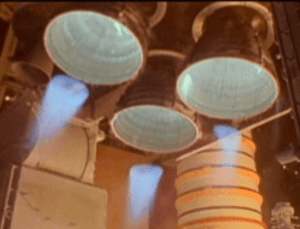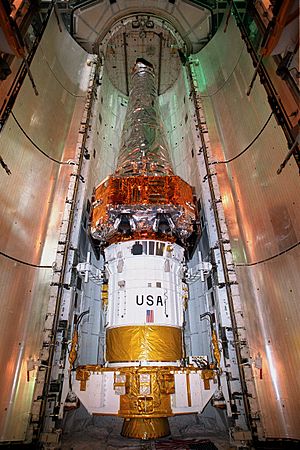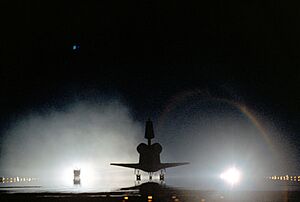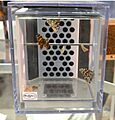STS-93 facts for kids

Chandra and its Inertial Upper Stage, prior to deployment from Columbia's payload bay
|
|
| Mission type | Satellite deployment |
|---|---|
| Operator | NASA |
| Mission duration | 4 days, 22 hours, 49 minutes, 34 seconds |
| Distance travelled | 2,890,000 km (1,796,000 mi) |
| Orbits completed | 80 |
| Spacecraft properties | |
| Spacecraft | Space Shuttle Columbia |
| Launch mass | 122,534 kg (270,142 lb) |
| Landing mass | 99,781 kg (219,980 lb) |
| Payload mass | 22,780 kg (50,222 lb) |
| Crew | |
| Crew size | 5 |
| Members |
|
| Start of mission | |
| Launch date | 23 July 1999, 04:31:00 UTC |
| Launch site | Kennedy LC-39B |
| End of mission | |
| Landing date | 28 July 1999, 03:20:35 UTC |
| Landing site | Kennedy SLF Runway 33 |
| Orbital parameters | |
| Reference system | Geocentric |
| Regime | Low Earth |
| Perigee | 260 kilometres (160 mi) |
| Apogee | 280 kilometres (170 mi) |
| Inclination | 28.4 degrees |
| Period | 90 minutes |
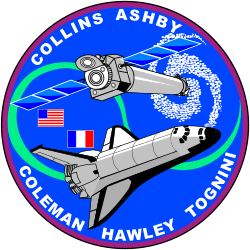 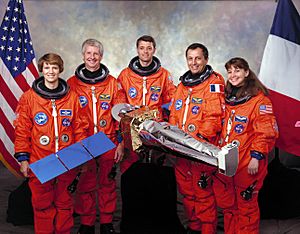 Left to right: Collins, Hawley, Ashby, Tognini, Coleman |
|
STS-93 was a Space Shuttle mission launched in 1999. It was a very important flight for several reasons. It was the 95th launch of the Space Shuttle program and the 26th flight for the Space Shuttle Columbia. It was also the 21st time a Space Shuttle launched at night.
A major highlight of STS-93 was that Eileen Collins became the first woman to command a Space Shuttle mission. The main goal of this mission was to put the Chandra X-ray Observatory into space. This was the heaviest payload ever carried by a Space Shuttle, weighing over 22,700 kilograms (25 tons). The launch was first planned for July 20 but was delayed. It successfully launched three days later on July 23, 1999. After this mission, Columbia went out of service for upgrades and did not fly again until 2002.
Contents
Meet the Astronauts: STS-93 Crew
The STS-93 mission had a crew of five skilled astronauts. Here are the brave individuals who flew on this historic flight:
| Position | Astronaut | |
|---|---|---|
| Commander | Third spaceflight |
|
| Pilot | First spaceflight |
|
| Mission Specialist 1 | Second and last spaceflight |
|
| Mission Specialist 2 | Fifth and last spaceflight |
|
| Mission Specialist 3 | Second spaceflight |
|
Launch Challenges: Problems During Ascent
The launch of STS-93 faced some challenges. During the engine start, a small metal pin came loose from one of the Space Shuttle's main engines. This pin hit the engine's nozzle, causing three cooling tubes to break and leak hydrogen. Even with this leak, the launch continued as planned.
Electrical Short and Engine Performance
About five seconds after liftoff, an electrical problem happened. It affected the main control unit of the center engine and the backup unit of the right engine. Luckily, each engine had a backup system, so they kept working. If two engines had shut down, it would have been very dangerous for the Columbia and its crew. Engineers later found that the electrical short was caused by wires that were not placed correctly and rubbed against a screw. This led to checks of wiring on all Space Shuttles.
Because of the hydrogen leak, the right engine used more oxidizer than normal to keep its power up. This caused all three engines to shut down a little early because they ran out of liquid oxygen sooner than expected. Even with this, the Space Shuttle safely reached its planned orbit and completed its mission. This event led to changes in how engines were repaired, making sure damaged parts were replaced instead of just plugged.
First Launch Attempt Scrubbed
Three days before the successful launch, the first attempt was stopped just seven seconds before the engines were supposed to start. A control operator noticed a sudden increase in hydrogen gas in the shuttle's engine area. It was later found that the instrument measuring the gas had a temporary problem. The system worked fine before and during the later successful launch attempts.
Mission Goals: What STS-93 Achieved
The main goal of the STS-93 mission was to deploy the Chandra X-ray Observatory. This observatory was designed to study X-rays from very hot and energetic parts of the universe, like the gas left behind after stars explode. At the time, Chandra was the most advanced X-ray telescope ever built.
Other Experiments and Payloads
Besides Chandra, STS-93 carried many other scientific experiments. These included:
- Midcourse Space Experiment (MSX): Studied space objects and Earth's atmosphere.
- Shuttle Ionospheric Modification with Pulsed Local Exhaust (SIMPLEX): Researched how the shuttle's exhaust affects Earth's upper atmosphere, called the ionosphere.
- Southwest Ultraviolet Imaging System (SWUIS): Used a special telescope to take pictures of astronomical objects in ultraviolet light.
- Gelation of Sols: Applied Microgravity Research (GOSAMR): Looked at how gels form in microgravity to make better ceramic materials.
- Space Tissue Loss – B (STL-B): Observed how cells behave in space using a video microscope.
- Light mass Flexible Solar Array Hinge (LFSAH): Tested new types of hinges for solar panels that could unfold smoothly in space.
- Cell Culture Module (CCM): Studied how microgravity affects muscle, bone, and blood vessel cells.
- Shuttle Amateur Radio Experiment – II (SAREX – II): Allowed astronauts to talk to amateur radio operators on Earth, including students.
- EarthKAM: Took pictures of Earth using a camera in the shuttle's window.
- Plant Growth Investigations in Microgravity (PGIM): Studied how plants grow in space and how they react to stress.
- Commercial Generic Bioprocessing Apparatus (CGBA): A device for processing and storing experiment samples in a controlled temperature.
- Micro-Electrical Mechanical System (MEMS): Tested tiny devices like accelerometers and gyroscopes in space.
- Biological Research in Canisters (BRIC): Investigated the effects of spaceflight on small insects and plants.
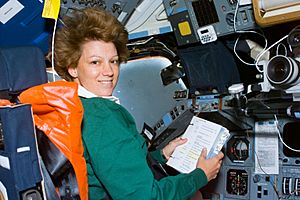
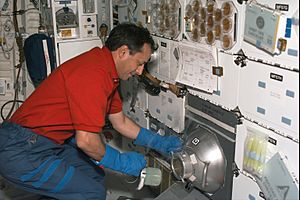
Landing and Special Cargo
Columbia's landing at Kennedy Space Center was the twelfth night landing in the Space Shuttle program's history. Most shuttle landings happened at Kennedy Space Center.
Rare Gold Coins on Board
In 2001, it was revealed that the United States Mint had made 39 special gold Sacagawea dollar coins in 1999. These coins were made from special gold blanks. The reason for making them is not fully known, but some believe it was to offer special collector's items.
Most of these coins were later melted down, but 12 of them were carried aboard Space Shuttle Columbia during the STS-93 mission in July 1999. Two of these rare coins were later shown at public events. The remaining 12 coins are now kept safely at Fort Knox. These coins are considered very unique because of how they were made and their journey into space. In 2007, the Mint announced they would publicly display these 12 space-flown gold dollars for the first time.
Wake-up Calls: Music in Space
Astronauts in space are often woken up with a special piece of music. This tradition started during the Apollo 15 mission. Each song is chosen carefully, sometimes by the astronauts' families. The music often has a special meaning to an astronaut or relates to their daily tasks in space.
| Flight day | Song | Artist/composer |
|---|---|---|
| Day 2 | "Beep Beep" | Louis Prima |
| Day 3 | "Brave New Girls" | Teresa |
| Day 4 | "Someday Soon" | Suzy Bogguss |
| Day 5 | "The Sound of Silence" | Simon and Garfunkel |
| Day 6 | "A Little Traveling Music" | Barry Manilow |
Images for kids
See also
 In Spanish: STS-93 para niños
In Spanish: STS-93 para niños


